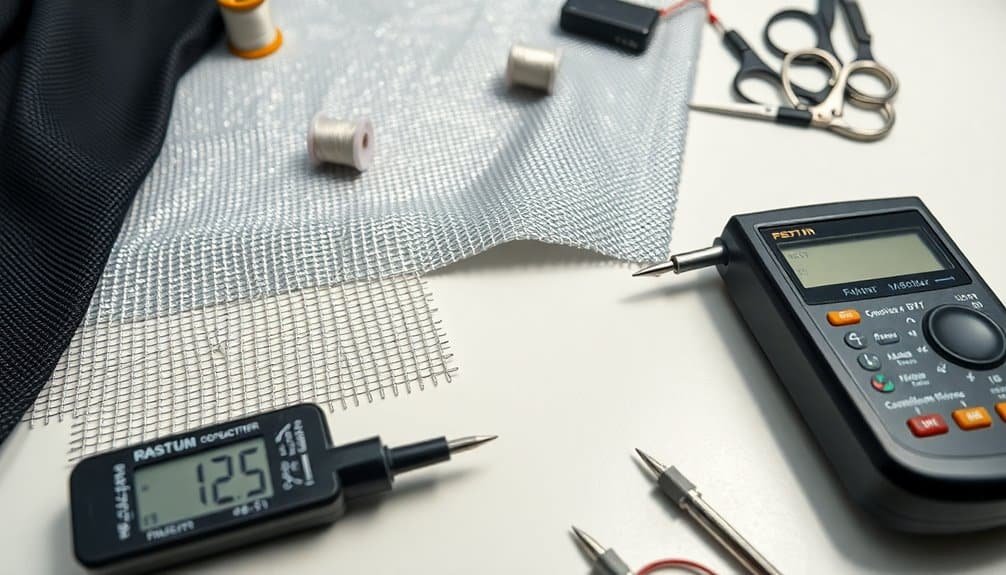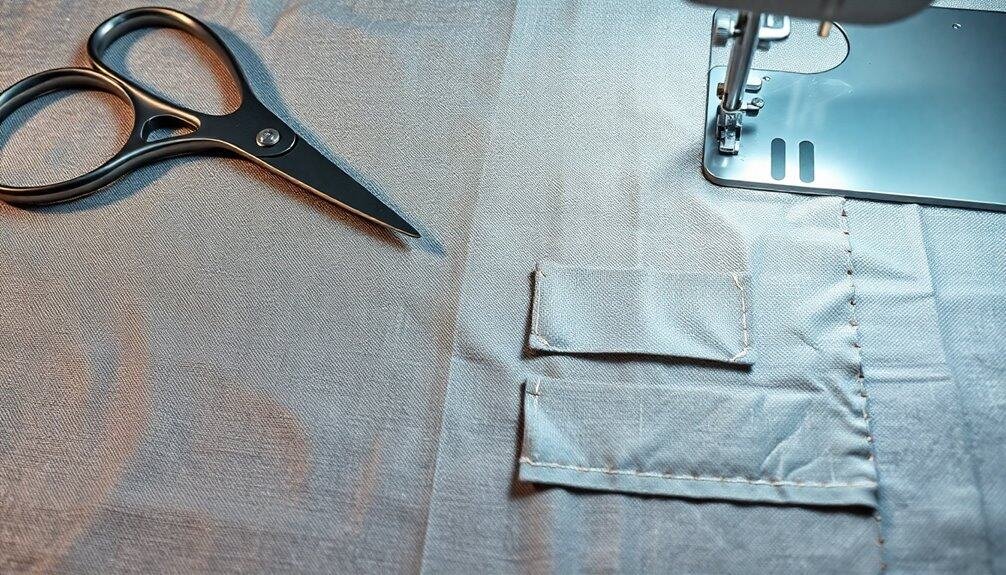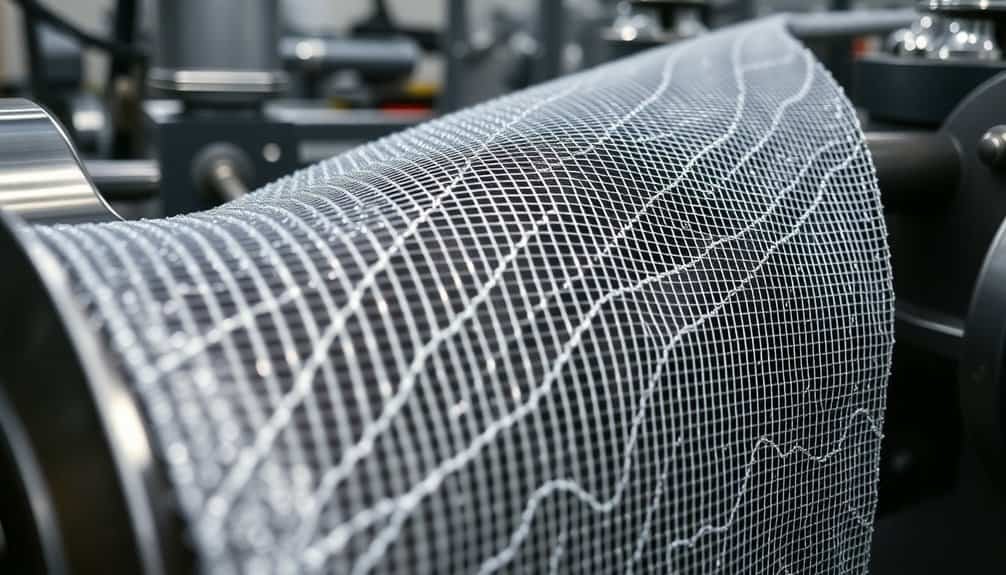Using Faraday Fabrics for DIY Projects

Faraday fabrics, composed of copper and nickel, offer exceptional electromagnetic shielding, often surpassing 120dB attenuation. Use these materials to craft protective pouches, RF-shielded enclosures, or Faraday bags for your electronics.
For sturdy construction, employ conductive thread when cutting and sewing. Discover innovative DIY applications to enhance EMF protection and personal privacy with these versatile materials.
Disclaimer: As an affiliate, I may collect a share of sales from the links on this page.
Understanding Faraday Fabrics: Composition and Properties

When exploring Faraday fabrics, it’s essential to recognize their unique composition and shielding properties.
These fabrics often feature a blend of copper and nickel, enhancing electromagnetic shielding. Many integrate durable polyester fibers for improved texture and longevity. The use of copper wire mesh in conjunction with Faraday fabrics can further optimize EMF protection. Their metallic conductive layers block a range of signals, providing effective coverage from cellular to GPS frequencies. Attenuation levels can reach over 120dB, ensuring substantial protection. Some designs are waterproof and utilize ripstop materials for tear resistance. This combination of features makes Faraday fabrics versatile for various applications, from clothing to protective enclosures, catering to specific project requirements efficiently. Additionally, they are designed for DIY Faraday cages, enabling users to create custom electromagnetic defense solutions.
Creative DIY Projects Utilizing Faraday Fabrics
Faraday fabrics offer numerous opportunities for innovative DIY projects that enhance protection against electromagnetic interference (EMI) and radio-frequency interference (RFI).
You can implement these creative ideas to safeguard your devices:
- Faraday Bags: Protect your electronics from EMI and RFI.
- RF Shielded Enclosures: Encapsulate tablets for added defense.
- DIY Router Covers: Block EMFs and improve privacy, helping to reduce exposure to harmful radiation.
- Faraday Pockets: Line pockets to shield personal items from RFID scanning. The concept of Faraday Pockets is particularly useful for silencing devices in public spaces.
- Protective Pouches: Create cases for smartphones and smartwatches using Faraday fabric.
These projects combine functionality and protection, making them ideal for anyone interested in DIY electronics safety.
Best Practices for Cutting, Sewing, and Assembling

Cutting, sewing, and assembling Faraday fabric requires attention to detail for effective results. Use scissors, razor blades, or utility knives for clean cuts on a stable surface. Incorporate a ruler for precision to avoid errors. Wear gloves to prevent oils from staining the conductive material. Additionally, be cautious as the fabric is tear-resistant which allows for easy cutting but necessitates careful handling to maintain integrity.
For sewing, opt for conductive thread to enhance shielding, though regular thread is acceptable. Prepare a pattern before sewing to guarantee proper fit. Reinforce seams with additional stitching or tape.
When assembling, confirm the cage encloses devices completely, cover all surfaces with fabric, and seal gaps with Faraday tape for effective shielding.
Custom Solutions for Personal Privacy and EMF Protection
Custom solutions for personal privacy and EMF protection are essential as concerns grow over data security and exposure to electromagnetic fields.
Faraday fabrics offer several practical uses for this purpose:
- Shield against RF signals (low MHz to 40GHz).
- Create DIY faraday cages for smartphones and laptops.
- Block RFID signals to combat credit card skimming.
- Layer multiple fabrics for enhanced shielding.
- Enclose Wi-Fi routers to minimize EM pollution.
- They are made from a blend of materials including metal-coated yarns for effective shielding.
Industrial Uses and Applications of Faraday Fabrics

As understanding of electromagnetic interference grows, industries increasingly turn to specialized fabrics for protection.
Faraday fabrics, composed of metals like copper or nickel, effectively shield against EMF and RF radiation. These materials find applications in construction, where they line walls to minimize interference, and secure rooms to block signal penetration.
In military settings, they protect equipment from electronic attacks and guarantee secure communications. Labs use these fabrics to shield sensitive instruments and create controlled testing environments.
Additionally, manufacturers utilize Faraday fabrics to safeguard electronic components during production and transportation, guaranteeing compliance with EMF exposure regulations while maintaining operational integrity.
Frequently Asked Questions
Can I Wash Faraday Fabrics Without Damaging Their Properties?
You can’t machine wash Faraday fabrics, as it may damage their properties. Instead, hand wipe them gently with a damp cloth. Avoid soaking, strong detergents, and high heat to preserve their effectiveness.
How Do I Test the Effectiveness of My Faraday Project?
To test your project’s effectiveness, seal a device inside your Faraday enclosure and try to communicate with it. If you can’t connect, it’s likely your project’s working well to block electromagnetic interference.
Where Can I Buy Faraday Fabrics Online?
Imagine shielding your devices from unwelcome signals. You can buy Faraday fabrics online at MOS Equipment, Faraday Defense, Walmart, or Redemption Shield—each offering unique options for your specific electronic protection needs.
Are There Any Health Risks Associated With Using Faraday Fabrics?
There aren’t definitive health risks tied to Faraday fabrics themselves, but it’s wise to contemplate electromagnetic fields’ potential effects, like fatigue or headaches. Taking precautions, including using such fabrics, can enhance your overall well-being.
Can Faraday Fabrics Be Used for Outdoor Applications?
Absolutely, you can use Faraday fabrics for outdoor applications. Their waterproof features and durability guarantee they withstand weather conditions, making them perfect for tents, bags, or any gear where protection against the elements is essential.
Conclusion
Faraday fabrics are ideal for DIY projects focused on EMF protection, blocking up to 99% of electromagnetic radiation. Their versatility and effectiveness make them valuable for personal and industrial uses in today’s tech-driven world.


